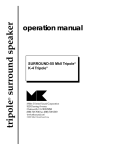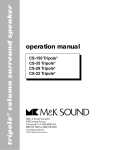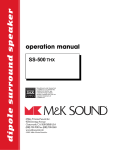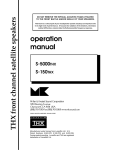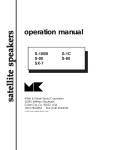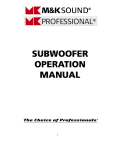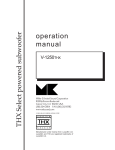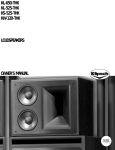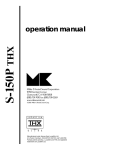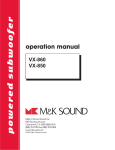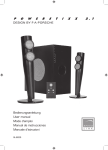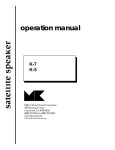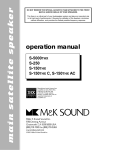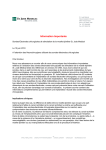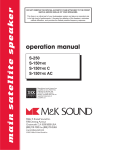Download MK Sound SS-150THX Speaker System User Manual
Transcript
SS-150THX tripole surround speaker operation manual Manufactured under license from Lucasfilm Ltd. U.S. Patent Nos. 5,043,970, 5,189,703, and 5,222,059. Foreign patents pending. Lucasfilm and THX are registered trademarks of Lucasfilm Ltd. Miller & Kreisel Corp. Miller & Kreisel SoundSound Corporation 9351 Deering Ave. 10391 Jefferson Boulevard CA 91311 Culver City,Chatsworth CA 90232 USA 818-701-7010 (310) 204-2854 FAX (310) FAX 818 701-0369 202-8782 © 1996 MILLER & KREISEL SOUND CORP. http://www.mksound.com page 2 SS-150THX satellite speaker TABLE OF CONTENTS 1. 2. 3. 4. 5. 6. 7. 8. 9. 10. 11. 12. 13. INTRODUCTION.............................................................................................................3 THE HOME THX AUDIO SPEAKER SYSTEM.......................................................3 THE TRIPOLE SURROUND SPEAKER DESIGN.......................................................3 INSTALLATION OF YOUR SS-150THX SPEAKERS............................................................4 SS-150THX SPEAKER HOOK-UP.........................................................................................5 PLACEMENT OF THE SS-150THX AS A SURROUND CHANNEL SPEAKER...................7 CUSTOM MODES & REMOTE OPERATION...............................................................8 SPEAKER PHASING TEST.........................................................................................9 SPEAKER DAMAGE & HOW TO AVOID IT.................................................................8 IF YOU NEED SERVICE......................................................................................................10 SPECIFICATIONS.........................................................................................................10 CABINET MAINTENANCE...........................................................................................10 USE WITH OMNIMOUNT BRACKETS.......................................................................10 DIAGRAMS FIGURE 1 FIGURE 2 FIGURE 3 FIGURE 4 FIGURE 5 USING THE SS-150THX MOUNTING BRACKETS................................................4 BASIC WIRING WITH THE SS-150THX................................................................5 WIRING THE SS-150THX FOR TRIPOLE OPERATION....................................6 WIRING THE SS-150THX FOR THX DIPOLE OPERATION......................................6 USE OF AN OMNIMOUNT BRACKET..............................................................11 page 3 SS-150THX satellite speaker 1. INTRODUCTION Congratulations! Your new M&K SS-150THX Tripole surround speaker will give you years of unmatched enjoyment and excitement while listening to your favorite musical and audio/video sources, whether in Dolby Digital or other discrete multichannel digital systems, Dolby Pro-Logic, or your processor's enhanced stereo modes. We encourage you to read this owner’s manual, as there is a great deal of information provided here to help you get the best possible performance. If you have any questions about your speaker system, please contact your M&K dealer or call the M&K factory directly at (310) 204-2854, from 8:30 AM to 5:00 PM Pacific Time, Monday through Friday. We will be happy to help you with any question, no matter how simple or complex it may be. 2. THE HOME THX AUDIO SPEAKER SYSTEM Your choice of an M&K Home THX Audio speaker system assures you of achieving the state of the art in home theatre music and video reproduction. The precise and exacting standards developed by Lucasfilm's Home THX division assure that you will hear every element of film sound — from the softest brush of an object against an actor's clothing to the awesome impact of effects such as an exploding planet — with the same sonic quality heard by the film's director and sound designer as they created the final mix of sound on the studio's dubbing stage. To do this in a home environment requires different equipment and standards than are found in a THX motion picture theatre. The standards developed for Home THX Audio are critically important to achieving the following performance attributes: - wide frequency range, extending to the limits of audibility - smooth, naturally balanced overall sound - excellent dialog intelligibility - wide dynamic range with extremely low distortion - well-matched timbre (tonal balance) between front speakers and surrounds - precise localization of specific sounds (as in special effects) - envelopment by ambient soundfield (without any localization of individual speakers to distract from the action on-screen - superb performance with musical sources The unsurpassed quality of your M&K Home THX Audio speaker system means that all of the excitement and emotional involvement of films and music will be brought to life in your home. Turn down the lights, and let the experience begin! 3. THE TRIPOLE SURROUND SPEAKER The Tripole is a new concept in surround channel speaker design, offering the performance aspects of two different types of speakers. Think of it as a dipole surround speaker that includes a very high quality direct radiating speaker in the same cabinet. The speaker can operate in two modes: Tripole and Dipole. You can select these modes by inserting or removing a jumper on the back of the speaker. They also can be accessed by using an external amplifier switchbox (not available from M&K). See Section 7 on Page 8 for more information. The mode you should use is dependent on your room environment, the source material you are playing, and your personal preference. As a Dipole (the THX configuration), it radiates sound mostly from its left and right baffles, which are at a 15 degree angle to the front baffle. Some sound (in the midbass region) is produced by the front woofer driver. As a Tripole, the front baffle drivers (direct radiator) operate full range. The side Dipole drivers also operate, so sound is radiated on three axis. This means that the speaker can simultaneously produce a directional stereo image in the surround channels and an enveloping sound that wraps around the listeners. The directional qualities and stereo imaging may be preferred for playing back the "split" (stereo) surrounds of 5.1 channel discrete digital recordings The Tripole mode is not necessarily better than the Dipole mode for 5.1 channel material. We strongly recommend experimentation to see which mode works best in your listening environment. SS-150THX satellite speaker page 4 Most users will set the speaker to a single mode for all playback, and we recommend that the choice be made based upon room conditions. Still, some users may prefer the Dipole mode for some material and the Tripole mode for other material. If you have questions regarding this, please contact your M&K dealer or the M&K factory. 4. INSTALLATION OF YOUR SS-150THX SPEAKERS Your M&K SS-150THXs can be installed in a variety of ways. Choosing the correct location, however, is important. READ SECTION 6 (page 7) BEFORE DECIDING WHERE TO INSTALL YOUR SS-150THXs. They can be placed on tall stands (M&K ST series); shelves or bookcases; or more permanently mounted using brackets or a ceiling suspension system. To make their installation as easy as possible, we have provided an integral flush-mount bracket that allows you to install the SS-150THX quickly and securely. Integral mounting hardware is also provided for an Omnimount 50 series mounting bracket. Remember that when the speaker is installed above the listeners' heads, the tweeter should be at the bottom. Your SS-150THX speakers have one flush-mount wall bracket attached to each cabinet, mounted on the side that sits against the side wall. Also enclosed is a kit consisting of two matching brackets that attach directly to the wall, as well as all necessary mounting screws and drywall inserts. In order to use these brackets, see Figure 1 and the enclosed template, and then follow these instructions. The initial step is to determine where you will locate your SS-150THX s. See Section 6 (page 7), for guidelines on where to locate the speakers. Then, using the template sheet enclosed (which is reproduced below), mark holes on the wall where the brackets will be permanently mounted. We strongly recommend that the bracket be mounted into a wall stud. This will provide the most secure mounting. When locating the mounting holes into the stud, first locate its center. Please use the separate enclosed sheet to mount the speaker to the wall. The reproduction of the sheet that appears below is not to scale and is reproduced only for reference. FIGURE 1 USING THE SS-150THX MOUNTING BRACKET page 5 SS-150THX satellite speaker If you are mounting the bracket to a wall stud, drill two 3/32" holes per bracket. Remember that the wallboard material is 1/2" or 5/8" inches thick, and you will drill through this before meeting the stud. If you are mounting the bracket to drywall with the plastic anchors, drill two 1/4" pilot holes per bracket. Once all holes have been drilled, remove the template from the wall. Press the plastic wall anchors into the 1/4" pilot holes until they are flush with the wall. Tap them gently into place if necessary. Tape the four corners of the template sheet to the wall in the location you have selected, using a carpenter's level to make sure the line marked "LEVEL TEMPLATE TO THIS LINE" is level. The template sheet has locations marked for two mounting holes for the bracket needed to hang the SS-150THXs. Once you are absolutely certain that you have the correct location, you are ready to drill the pilot holes. Go ahead and drill right through the paper template into the wall. Re-check your measurements (especially making sure the holes are level) at least once before drilling. Follow the instructions on the template. WARNING: IT IS POSSIBLE THAT ELECTRICAL WIRING MAY BE LOCATED BEHIND THE WALL AT THE LOCATION THAT YOU HAVE SELECTED. BE EXTREMELY CAREFUL ANY TIME YOU DRILL INTO A WALL. Once the holes are drilled, place one bracket against the wall, making sure that the "tongue" (the portion that engages the bracket on the speaker) is facing away from the wall and pointing up. Using the two #6 - 1 3/4" wood screws provided, fasten this bracket to the wall. BE VERY CAREFUL. DO NOT FORCE THE PLASTIC ANCHORS THROUGH THE WALL OR OVERTIGHTEN THE SCREWS. Install the second bracket in the same fashion. That's it! All that is left for you to do is attach the speaker wire to the input terminals (Section 5, below), and, from the top, gently slide the speaker into place against the wall. Do the same for the other channel. 5. SS-150THX SPEAKER HOOK-UP LEFT SURROUND SPEAKER / RIGHT SURROUND SPEAKER Your SS-150THXs come in left and right channel versions. Externally, both speakers may appear to be identical, but in fact it is critical that the correct speaker be used in each channel. On the back of the speaker is a label with an arrow printed with the nomenclature "Point Arrow Towards Screen." To properly install the SS-150THX s, make sure that the arrow printed on each speaker is oriented properly. When the speakers are on the side walls, the arrows should be pointed towards the television screen. When the speakers are mounted on the back wall, the arrows should point to the nearest corner. The arrows will not be visible once the speaker is installed. WIRING THE SS-150THX The Positive ( + ) lead from your surround channel amplifier or receiver should be connected to the RED ( + ) FIGURE 2 BASIC WIRING WITH THE SS-150THX (one channel only is shown for clarity) Connect your amplifier to terminals 1 and 2. 1 SS-150THX TRIPOLE SURROUND SPEAKER 2 For remote control operation, see your owner's manual. DO NOT CONNECT YOUR AMPLIFIER TO TWO RED TERMINALS. INPUT 4 ohms MADE IN USA FOR THX (DIPOLE) OPERATION: remove jumper between terminals 3 and 4 3 FOR TRIPOLE OPERATION: install jumper between terminals 3 and 4 d e r u t c a f n r Me d u e s n c i l m o r f m l i f s a c u L . d t L . S U t n e a P . s o N ; 0 7 9 , 3 ;4 60 1 5 , 9 3 0 5 7 , 9 8 1 5 d n a . 9 5 0 , 2 5n g i er o F s t n e a p . g n i d e p m l i f s a c u L d n a X H T er a d er t s i kg e ar m d t f o m l i f s a c u L . d t L MILLER & KREISEL SOUND CORPORATION 4 _ 10391 Jefferson Boulevard., Culver City, CA 90232 Voice (310) 204-2854 Fax (310) 202-8782 + LEFT SURROUND _ + RIGHT SURROUND AMPLIFIER page 6 SS-150THX satellite speaker "INPUT" terminal labelled "1", and the Negative ( — ) lead from your amplifier or receiver should be connected to the BLACK ( — ) "INPUT" terminal labelled "2". See Figure 2 on Page 5. TRIPOLE OR DIPOLE OPERATION To operate in the Tripole mode, the jumper between the terminals labelled "3" and "4" must be in place. To operate the speaker in the THX Dipole mode, the jumper between the terminals labelled "3" and "4" must be removed. Do not throw away or lose this jumper. See Figures 3 and 4 on page 6. VERY IMPORTANT: The sensitivity of the speaker is slightly higher in the Tripole position. For critical listening, when switching from one mode to another, you should re-calibrate the level of the surround channels. FIGURE 3 WIRING THE SS-150THX FOR THX (DIPOLE) OPERATION (one channel only is shown for clarity) Connect your amplifier to terminals 1 and 2. Disconnect the Jumper between terminals 3 and 4 1 SS-150THX TRIPOLE SURROUND SPEAKER 2 For remote control operation, see your owner's manual. DO NOT CONNECT YOUR AMPLIFIER TO TWO RED TERMINALS. INPUT 4 ohms MADE IN USA FOR THX (DIPOLE) OPERATION: remove jumper between terminals 3 and 4 3 FOR TRIPOLE OPERATION: install jumper between terminals 3 and 4 d e r u t c a f n r eM d u e s n c i l m o r f m l i f s a c u L . d t L . S U t n e a P . s o N ; 0 7 9 , 3 ;4 60 1 5 , 9 3 0 5 7 , 9 8 1 5 d n a . 9 5 0 , 2 5n g i er o F s t n e a p . g n i d e p m l i f s a c u L d n a X H T er a d er t s i kg e ar m d t f o m l i f s a c u L . d t L MILLER & KREISEL SOUND CORPORATION 4 10391 Jefferson Boulevard., Culver City, CA 90232 Voice (310) 204-2854 Fax (310) 202-8782 _ _ + + RIGHT SURROUND LEFT SURROUND AMPLIFIER FIGURE 4 WIRING THE SS-150THX FOR TRIPOLE OPERATION (one channel only is shown for clarity) Connect your amplifier to terminals 1 and 2. Connect the Jumper between terminals 3 and 4 1 SS-150THX TRIPOLE SURROUND SPEAKER 2 For remote control operation, see your owner's manual. DO NOT CONNECT YOUR AMPLIFIER TO TWO RED TERMINALS. INPUT 4 ohms MADE IN USA FOR THX (DIPOLE) OPERATION: remove jumper between terminals 3 and 4 3 FOR TRIPOLE OPERATION: install jumper between terminals 3 and 4 d e r u t c a f n r eM d u e s n c i l m o r f m l i f s a c u L . d t L . S U t n e a P . s o N ; 0 7 9 , 3 ;4 60 1 5 , 9 3 0 57 , 9 8 1 5 d n a . 9 5 0 , 2 5n g i e r o F s t n e a p . g n i d e p m l i f s a c u L d n a X H T er a d er t s i kg e ar m d t f o m l i f s a c u L . d t L MILLER & KREISEL SOUND CORPORATION 4 _ 10391 Jefferson Boulevard., Culver City, CA 90232 Voice (310) 204-2854 Fax (310) 202-8782 + LEFT SURROUND _ + RIGHT SURROUND AMPLIFIER SS-150THX satellite speaker page 7 6. PLACEMENT OF THE SS-150THX AS A SURROUND CHANNEL SPEAKER This speaker is designed to be oriented with the front tweeter closest to the listeners. When the speaker is mounted above the listeners' heads, make certain that the tweeter on the front baffle is at the bottom. If the speaker is mounted below listeners' heads, the tweeter should be at the top. Your SS-150THX speakers are designed to be used as surround channel speakers, especially in a Home THX system, playing Dolby Digital, other discrete digital, or Pro-Logic sources. The SS-150THX will achieve excellent results in non-THX systems as well. While not specifically designed to be used as front channel or as stand-alone stereo speakers, feel free to experiment with them. The instructions given here apply to surround channel applications (including use for multi-channel music modes such as ambience recovery or acoustical environment synthesis). The surround channels can be installed in a wide variety of locations, but in some environments, they are a challenge to install. If you have questions, please call the M&K factory. We will be happy to discuss them with you. PLACEMENT WHEN USED IN THX DIPOLE MODE In general, the SS-150THXs should be located relatively high on the side walls of the room, to the sides of the listening position. In fact, the key to placement of the SS-150THXs in THX mode is that they radiate sound to the front and the rear of the room, as opposed to directly at the listeners. Therefore the speakers should be directly to the left and to the right of the listeners, which places the listeners in the NULL of the speaker radiation pattern. This configuration prevents listeners from localizing the surround speakers as a direct source of sound. Instead, they are enveloped by a diffuse ambient soundfield, hearing only indirect sound reflected from various room surfaces. a. POSITION RELATIVE TO SEATING In THX Dipole mode, the SS-150THX speakers should be located on the side walls adjacent to the seating position. If there is one row of seats, the SS-150THXs should be located directly to the left and to the right of this row of seats. If there are multiple rows of seats, then the SS-150THX s should be located directly to the left and right of the geometric center of the listening area. If the SS-150THXs cannot be located directly to the sides of the seating area, it is better for them to be towards the back of the room, behind the listening position, rather than in the front of the room. You want to avoid having the surrounds producing sound in front of the listeners, which would be between the listening position and the screen. b. HEIGHT The SS-150THX should be located above the listeners' heads. Preferably the cabinet's bottom will be at least two feet above a seated listener's head. In fact, if at all possible, the speakers should be located above standing listeners' heads, so that people walking around the room will also hear an enveloping sound and will be unable to localize the speakers. Remember that this speaker should produce an enveloping, non-directional sound, so there is no requirement that it be located particularly close to the listeners. For additional information regarding speaker placement, see your dealer and the THX Installation Manual. PLACEMENT WHEN USED IN TRIPOLE MODE In Tripole mode, the SS-150THXs are less critical of placement. They still should be located high on the wall, to the sides or behind the listening position. They can be mounted on the back wall of the room. The Tripole mode radiates sound to the front and the rear of the room in addition to directly at the listeners. The usual installation will be mounted flush on the side or back wall of the room, but improved results may be obtained by angling them either towards or away from the main listening position. If you want a more directional sound quality, point the front baffle more directly towards the listeners. If you want a more diffuse sound quality, point the front baffle towards the back wall. a. POSITION RELATIVE TO SEATING In Tripole mode, the SS-150THX speakers can be located either adjacent to or behind the seating position. For maximum enveloping quality, with one row of seats, the SS-150THXs should be located directly to the left and to the right of this row of seats. If there are multiple rows of seats, then the SS-150 THXs would then be located directly to the left and right of the geometric center of the listening area. If they cannot be located exactly adjacent to the seating area, it is better for them to be located slightly towards the back of the room, behind the listening positions, rather than in the front of the room, between the listening position and the screen. b. HEIGHT The SS-150THX should be located relatively close to the ceiling. Placement above the listeners' heads is very SS-150THX satellite speaker page 8 important, preferably with the cabinet's bottom at least two feet above a seated listener's head. In fact, it is even better if the speakers are located above standing listeners' heads, for when listeners are standing or walking around the room. c. WALL LOCATION The SS-150THX can be mounted on either the side walls or on the back wall, or even directly in a corner. They can be flush on the wall, on shelves, on brackets, etc. The Tripole's great flexibility makes it very forgiving of room placement that is less than optimum. The Tripole will give you a combination of an enveloping sound with directionality. You will hear directional effects, and even imaging when the recording has these qualities. Yet at the same time you will also hear a diffuse sound from the Dipole drivers mounted on the left and right cabinet baffles. If the sound lacks the directionality you desire, point the front baffles directly at the main listening position. Omnimount brackets are very useful for this. If the sound is too directional, angle the speakers towards the back wall or the side wall surface directly behind them. By reflecting sound behind the listening position, you may increase the sense of envelopment in the sound. d. USE OF MULTIPLE PAIRS OF SURROUNDS Some listeners prefer multiple pairs of surround speakers. In very large rooms, this may even be necessary. Multiple speakers can make a dramatic improvement and provide a broader and deeper surround effect. When using multiple pairs of surround speakers, a symmetrical installation pattern works best. For example, one pair could be mounted on the back wall of the room, mounted equidistant from the back corners, with the other pair mounted on the side walls of the room, equidistant from the same back corners. When using two pairs of Tripoles, make sure that the speakers on the back wall have their arrows labelled "Point Arrow At Screen" pointed at the side walls of the room. 7. CUSTOM MODES & REMOTE OPERATION IMPORTANT: The following options are provided for enthusiasts and installers who wish to experiment with their systems. The design of the SS-150THX provides a tremendous amount of flexibility. Because it is designed as if it is two separate speakers (a Direct radiator and a Dipole), you can independently vary the amount of output from either the Direct radiator or the Dipole elements. By adjusting the ratio of sound produced by these elements, you can fine-tune the speaker to your listening environment or personal preference. You make these adjustments by choosing which input terminals, jumpers, and (if desired) resistors are used to connect the speaker to the amplifier. PLEASE NOTE: The sensitivity of the speaker is slightly different in each of these modes. For critical listening, when switching from one mode to another, you should re-calibrate the level of the surround channels. Regardless of configuration, the Ground (-) lead from the amplifier must connect to Terminal 2. a. THX Dipole Mode See page 6. To operate in the Dipole (THX) mode, connect the positive (+) lead to Terminal 1. Use no jumper. b. Tripole Mode See page 6. To operate in the Tripole mode, must connect the positive (+) lead to Terminal 1 and insert the jumper between terminals 3 and 4. c. Tripole With Attenuated Dipole Elements Compared to the standard Tripole configuration, the output from the Direct (front) drivers will be unchanged, but there will be significantly reduced output from the Dipole (side) drivers. To attenuate the Dipole elements, connect the positive (+) lead to Terminal 3, and insert the jumper between terminal 3 and 4. d. Tripole With Adjustable Attenuated Direct Radiator Compared to the standard Tripole configuration, the output from the Dipole (side) drivers will be unchanged, but there will be reduced output from the Direct drivers. This configuration will give you a sound more like the THX Dipole configuration. To adjust the attenuation of the Direct Radiator element, connect the positive (+) lead to Terminal 1 and insert a 5 watt resistor between terminals 3 and 4. The resistor can be any value between 2 and 11 ohms. The larger the value of the resistor, the greater the attenuation. e. Tripole With Adjustable Attenuated Dipole SS-150THX satellite speaker page 9 To adjust the attenuation of the Dipole element, connect the positive (+) lead to Terminal 3 and insert a 5 watt resistor between terminals 3 and 4. The resistor can be any value between 2 and 11 ohms. The larger the value of the resistor, the greater the attenuation. f. Tripole With Maximum Output From All Drivers (2.4 ohm impedance) Compared to the standard Tripole configuration, the output from the Dipole (side) drivers will be unchanged, but there will be significantly greater output from the Direct (front) drivers. To get maximum output from all drivers, connect the (+) lead from the amplifier to Terminal 1. Connect a jumper wire between Terminal 1 and Terminal 3. CAUTION: This configuration presents a 2.4 ohm load to the amplifier. Do not use this configuration unless your amplifier is rated to 2 ohms. g. Direct Radiator Only Mode There will be very little (virtually no) output from the Dipole (side) drivers. To operate as a Direct Radiator, connect the (+) lead from the amplifier to Terminal 3. Use no jumper. Remember, regardless of configuration, the Ground (-) lead must always connect to Terminal 2. REMOTE SWITCHING OF MODES If you want to be able to switch between any of the above modes, you can do so by using a speaker level switch box. The specific instructions will vary according to the particular switcher you are using and the , so this is section is intended to be general in nature. For example, to switch between THX Dipole mode and Tripole mode, connect one wire between Terminal 3 and the switcher Input. Connect a separate wire between Terminal 4 and one of the switcher outputs. For the THX Dipole mode, the switcher output connected to Terminal 4 should be turned off. For the Tripole mode, the switcher output should be turned on. Nothing else should be connected to the switch box, especially your amplifier. As another example, you can also use a switcher to direct the (+) signal from the amplifier to either Terminal 1 or Terminal 3, to switch between some of the custom modes described above. CAUTION: DO NOT WIRE THE SWITCH BOX SO TERMINAL 2 CAN BE CONNECTED TO ANY OTHER TERMINAL. If Terminal 2 is connected to Terminal 1, 3, or 4, the output of the power amplifier will be shorted, which will almost certainly damage the amplifier. 8. SPEAKER PHASING TEST In any system using a subwoofer separate from Satellite speakers, especially in multi-channel surround sound applications, a phasing test must be performed to insure proper phase in the system, in order to achieve optimum sound in the critical bass frequencies. Therefore, you must have correct phase among all the speakers in the system. We recommend using a test disc to compare the phase of the front channels, surround channels, and subwoofer. Test by comparing the phase between individual channels (starting with the front right and left) until you have established that all units have identical phase. 9. SPEAKER DAMAGE & HOW TO AVOID IT An important factor to consider with any speaker system is the potential for speaker damage. Even though your SS-150THXs have high power handling ability, they still can be damaged by relatively low powered amplifiers. While very few M&K speakers ever need service, the vast majority of those returned are not for manufacturing defects. Instead, they are returned because they have been overdriven, and almost always because the amplifier used was driven into clipping distortion. This damage is abuse, and is not necessarily covered under warranty. This distortion occurs when the demands of the music are greater than the amplifier's power. It can occur at 20 watts with a small amplifier, or at 400 watts with a large amplifier. Regardless, when this happens, the amplifier's output waveform (which usually looks like a smooth arc) is "clipped" off, exhibiting a flat top instead of the arc. This flat top contains multiples of the original amplified frequencies, sometimes at higher levels than the original signal itself. For tweeters, this can be very damaging, as this distortion is well above the audible range, where you will be unable to hear it, and where the tweeter is more vulnerable to damage. When an amplifier clips, its sound becomes harsh and grating, and a break-up is often audible in the bass frequencies. It will become uncomfortable to listen to, compared to a slightly lower volume level. When you are listening at high volume levels, be aware of the onset of clipping distortion, and turn the volume down slightly if the page 10 SS-150THX satellite speaker sound takes on the character described above. When tone controls or equalizers are used to boost frequencies, the problem occurs much more rapidly. Even a small boost of low or high frequencies can easily double the power requirement and lead to amplifier clipping at moderate levels. Therefore, you should use your tone controls judiciously, avoiding extreme boosts of the bass and treble controls, especially when you are listening at high volume levels. The best way to avoid speaker damage is to use common sense. Use moderate boosts of tone controls or equalizers, at the very most. Listen carefully for any harshness and break-up, especially at high volume levels, and turn down the volume when needed. If you cannot get enough volume, you may need to consider a higher-powered amplifier. If you have any questions about this, please contact M&K, and we will be happy to discuss it with you further. 10. IF YOU NEED SERVICE Contact your dealer or M&K with a complete description of the problem. Please have the unit's model and serial numbers (found on the back of the cabinet), date of purchase, and your dealer's name. You can call M&K between 8:30 AM and 5:00 PM Pacific Time, Monday through Friday, at (310) 204-2854. If you call outside these hours, leave a message, and we will return your call. DO NOT RETURN YOUR SPEAKERS TO THE FACTORY FOR SERVICE WITHOUT OBTAINING PRIOR AUTHORIZATION. Your SS-500THX speakers carry a five year limited parts and labor warranty. This warranty is transferable to new owners. It does not cover abuse, misuse, repairs by unauthorized service stations, speakers without serial numbers, and those damaged in shipping or by accident. If you have warranty questions, please contact M&K. 11. SPECIFICATIONS IMPEDANCE: MINIMUM POWER: RECOMMENDED POWER: MAXIMUM POWER: FREQUENCY RESPONSE: 4 ohms 10 watts RMS 50 watts RMS to 200 watts RMS 200 watts RMS unclipped peaks 80 Hz - 20 KHz (high frequencies above 8 KHz are not rolled off) 12. CABINET MAINTENANCE Treat the cabinet as you would any piece of fine furniture. Its painted black or white finish does not require any special maintenance; regular dusting with a lint-free cloth and periodic cleaning is all that is required. Matching paint can be used if necessary to repair any surface damage. 13. USE WITH OMNIMOUNT® BRACKETS The SS-150THX contains a threaded (3/8") insert, located on the speaker's back baffle. This allows the speaker to be securely fastened to wall-mount brackets offered by Omnimount Systems. The appropriate bracket is a special order part of the 50 series, known as the 53-RST. This part (order the 53-RST) is available from M&K Sound. For more information, including alternate mounting configurations such as ceiling mounts, contact Omnimount SS-150THX satellite speaker page 11 FIGURE 5 USE WITH AN OMNIMOUNT ® BRACKET SS-150THX USES OMNIMOUNT® 53-RST A single 3/8" threaded insert is located on the back baffle of the cabinet. Use only an Omnimount® 53 RST (special order) bracket. at (602) 829-8000. S-150THX Manual.pm6 rev 01.0796 7. CUSTOM MODES & REMOTE OPERATION SS-150THX satellite speaker page 12 IMPORTANT: The following options are provided for enthusiasts and installers who wish to experiment with their systems. The design of the SS-150THX provides a tremendous amount of flexibility. Because it is designed as if it is two separate speakers (a Direct radiator and a Dipole), you can independently vary the amount of output from either the Direct radiator or the Dipole elements. By adjusting the ratio of sound produced by these elements, you can fine-tune the speaker to your listening environment or personal preference. You make these adjustments by choosing which input terminals, jumpers, and (if desired) resistors are used to connect the speaker to the amplifier. Regardless of configuration, the Ground (-) lead from the amplifier must connect to Terminal 2. a. THX Dipole Mode See page 6. To operate in the Dipole (THX) mode, connect the positive (+) lead to Terminal 1. Use no jumper. b. Tripole Mode See page 6. To operate in the Tripole mode, must connect the positive (+) lead to Terminal 1 and insert the jumper between terminals 3 and 4. c. Tripole With Attenuated Dipole Elements Compared to the standard Tripole configuration, the output from the Direct (front) drivers will be unchanged, but there will be significantly reduced output from the Dipole (side) drivers. To attenuate the Dipole elements, connect the positive (+) lead to Terminal 3, and insert the jumper between terminal 3 and 4. d. Tripole With Adjustable Attenuated Direct Radiator Compared to the standard Tripole configuration, the output from the Dipole (side) drivers will be unchanged, but there will be reduced output from the Direct drivers. This configuration will give you a sound more like the THX Dipole configuration. To adjust the attenuation of the Direct Radiator element, connect the positive (+) lead to Terminal 1 and insert a 5 watt resistor between terminals 3 and 4. The resistor can be any value between 2 and 11 ohms. The larger the value of the resistor, the greater the attenuation. e. Tripole With Adjustable Attenuated Dipole To adjust the attenuation of the Dipole element, connect the positive (+) lead to Terminal 3 and insert a 5 watt resistor between terminals 3 and 4. The resistor can be any value between 2 and 11 ohms. The larger the value of the resistor, the greater the attenuation. f. Tripole With Maximum Output From All Drivers (2.4 ohm impedance) Compared to the standard Tripole configuration, the output from the Dipole (side) drivers will be unchanged, but there will be significantly greater output from the Direct (front) drivers. To get maximum output from all drivers, connect the (+) lead from the amplifier to Terminal 1. Connect a jumper wire between Terminal 1 and Terminal 3. CAUTION: This configuration presents a 2.4 ohm load to the amplifier. Do not use this configuration unless your amplifier is rated to 2 ohms. g. Direct Radiator Only Mode There will be very little (virtually no) output from the Dipole (side) drivers. To operate as a Direct Radiator, connect the (+) lead from the amplifier to Terminal 3. Use no jumper. Remember, regardless of configuration, the Ground (-) lead must always connect to Terminal 2. REMOTE SWITCHING OF MODES If you want to be able to switch between any of the above modes, you can do so by using a speaker level switch box. The specific instructions will vary according to the particular switcher you are using and the , so this is section is intended to be general in nature. For example, to switch between THX Dipole mode and Tripole mode, connect one wire between Terminal 3 and the switcher Input. Connect a separate wire between Terminal 4 and one of the switcher outputs. For the THX Dipole mode, the switcher output connected to Terminal 4 should be turned off. For the Tripole mode, the switcher output should be turned on. Nothing else should be connected to the switch box, especially your amplifier. As another example, you can also use a switcher to direct the (+) signal from the amplifier to either Terminal 1 or Terminal 3, to switch between some of the custom modes described above. CAUTION: DO NOT WIRE THE SWITCH BOX SO TERMINAL 2 CAN BE CONNECTED TO ANY OTHER TERMINAL. If Terminal 2 is connected to Terminal 1, 3, or 4, the output of the power amplifier will be shorted, which will almost certainly damage the amplifier.













